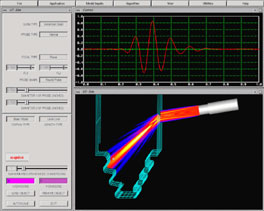Future Direction of Ultrasonic Inspection
Looking to the future, those in the field of NDE see an exciting new set of opportunities. The defense and nuclear power industries have played a major role in the emergence of NDE. Increasing global competition has led to dramatic changes in product development and business cycles. At the same time, aging infrastructure, from roads to buildings and aircraft, present a new set of measurement and monitoring challenges for engineers as well as technicians.
 Among the new applications of NDE spawned by these changes is the increased emphasis on the use of NDE to improve the productivity of manufacturing processes. Quantitative nondestructive evaluation (QNDE) both increases the amount of information about failure modes and the speed with which information can be obtained and facilitates the development of in-line measurements for process control.
Among the new applications of NDE spawned by these changes is the increased emphasis on the use of NDE to improve the productivity of manufacturing processes. Quantitative nondestructive evaluation (QNDE) both increases the amount of information about failure modes and the speed with which information can be obtained and facilitates the development of in-line measurements for process control.
The phrase, "you cannot inspect in quality, you must build it in," exemplifies the industry's focus on avoiding the formation of flaws. Nevertheless, manufacturing flaws will never be completely eliminated and material damage will continue to occur in-service so continual development of flaw detection and characterization techniques is necessary.
Advanced simulation tools that are designed for inspectability and their integration into quantitative strategies for life management will contribute to increase the number and types of engineering applications of NDE. With growth in engineering applications for NDE, there will be a need to expand the knowledge base of technicians performing the evaluations. Advanced simulation tools used in the design for inspectability may be used to provide technical students with a greater understanding of sound behavior in materials. UTSIM, developed at Iowa State University, provides a glimpse into what may be used in the technical classroom as an interactive laboratory tool.
As globalization continues, companies will seek to develop, with ever increasing frequency, uniform international practices. In the area of NDE, this trend will drive the emphasis on standards, enhanced educational offerings, and simulations that can be communicated electronically. The coming years will be exciting as NDE will continue to emerge as a full-fledged engineering discipline.